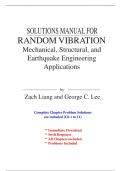solutionS MANUAL FOR
RANDOM VIBRATION
Mechanical, Structural, and
Earthquake Engineering
Applications
by
Zach Liang and George C. Lee
Complete Chapter Problem Solutions
are included (Ch 1 to 11)
** Immediate Download
** Swift Response
** All Chapters included
** Problems Included
,Ch1 Problems
1.1 Using Venn diagram to show that P(AB) = P(A) + P(B )- P(A∩B) by the fact that
the set (AB) can be seen as the union of disjoint sets ( A B ), ( A B ) and ( A B )
P(A∪B) = P( {A B} ) +P( {A B} ) + P({A∩B})
P(A) + P(B) = P( {A B} ) +P( {A B} ) +2 P({A∩B})
A B
U B
{A∪B} {A B}
A
{A B} {A B}
1.2 Find the sample spaces of the following random tests
a) The record of averaged score of mid term test of CIE520/MAE536. (Hint, we
have n people and the full score is 40
S = { i/n│i = 0, 1, 2, … 40n}
b) To continuously have 10 products up to standard, the total number of checked
products.
Suppose before these 10 products, we have k products not up to the standard,
, S = { 10+k│k = 0, 1, 2, … } = { 10, 11, 12, …}
c) Inspecting products which are marked “C” if certified and marked “D” if
defective, if two “D” are consequently checked, the inspection will be stopped.
Or, if four products have been checked, the inspection will also be stopped; the
records of the inspection.
S = { DD, CDD, DCDD, DCDC, DCCD, CCDD, CDCD,
DCCC,CCDC,CCCD,CCCC}
d) The coordinates of point inside a circle.
Cartesian : S = { (x,y) │x2 + y2 < r2}
Polar : S = S = { () │r≤
1.3 A and B denote two events respectively.
a) If AB AB Prove A = B
Since AB AB , we have AB AB AB AB .
Therefore, A A B AB B , which means UB = AU so that A= B
b) Suppose either A or B occurs; find the corresponding probability
The event that either A or B occurs can be expressed as AB AB. Its probability can
be written as
P[ AB AB] = PAB PAB P[A(U-B)]+ P[B(U-A)]
=P(A-AB) + P(B-AB) = P(A) + P(B) -2 P(AB)
1.4 For events A, B and C, P(A) = ½, P(B) = 1/3, P(C) = 1/5, P(A∩B) = 1/10, P(A∩C) =
1/15, P(B∩C) = 1/20, P(A∩B∩C) = 1/30, find
a) P(AB)
P(AB) = P(A) + P(B) – P(A∩B) = 11/15 = 0.7333
b) P( A B )
P( A B ) = P( A ) + P( B ) – P( A B) =9/10 =0.9
c) P(A BC)
P(A BC) = P(A) + P(B) + P(C) – P(A∩B) –P(A∩C) – P(B∩C) + P(A∩B∩C)
= 17/20 = 0.85
d) P( A BC )
P( A BC ) = P( A B )+ P(C) – P( A B C) = 4/15 + 1 /4 -7/60 =7/20 =0.35
e) P( A B C)




